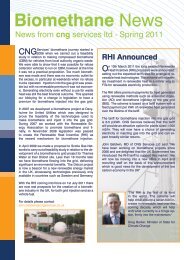Bio-SNG - CNG Services
Bio-SNG - CNG Services
Bio-SNG - CNG Services
Create successful ePaper yourself
Turn your PDF publications into a flip-book with our unique Google optimized e-Paper software.
BIO-<strong>SNG</strong> FEASIBILITY STUDY – ESTABLISHMENT OF A REGIONAL PROJECTAlthough many of the macroscopic properties of biomass are remarkably similar across a number ofspecies it is important to note that minor constituents can vary with the species 21 and undoubtedly withthe environment and soils in which they are grown. (Scientific literature is prolific on the subject of mineraltake-up from the environment, with some plant species being especially effective in accumulating, lead,zinc, mercury etc.) This is particularly important when considering the properties of biomass ashes,which in themselves are notably dissimilar to coal ashes, both in the amount and also their chemicalcomposition. This has implications for chosen gasifier operating conditions especially with respect to ashfusion temperatures and the volatile behaviour of certain alkali metal oxides at elevated temperatures.Furthermore, gas processing operations may be sensitive to small levels of both alkali metals and heavymetals in the de-activation of catalysts.The European Commission recognised the need for a systematic basis to describe solid biofuels and in2004 embarked upon a programme of work under CEN/335 entitled “Solid <strong>Bio</strong>fuels”. The objective of thework was to provide a scientifically informed basis for describing the properties of solid bio fuels for thepurpose of facilitating trade between producer and user, for informing process design, (esp. materialshandling), environmental permitting, communication with stakeholders and for quality management.4.4 WASTE MATERIALSOver 98% of the potential UK indigenous biomass resource is from waste products 22 . Municipal,commercial and industrial wastes therefore provide a valuable and ubiquitous source of biomass fuel.Combustible wastes arising from household collections, commercial-industrial waste and construction anddemolition 23 . Whilst there is significant political pressure to increase recycling, analysis by Lee et alclearly shows that even extensive recycling will still leave a substantial tranche of residual material forwhich recycling is not possible. This data, Figure 4.2 shows that the residual waste from municipalsources is predicted to be fairly constant at c.28million tonnes and from commercial/industrial sources at50million tonnes. Of this c.17million and c.24million tonnes are considered to be biomass respectively.The authors estimate this residual waste resource (biogenic and non-biogenic) to be ~700PJ from bothMWS and C&I streams. This full potential analysis does not account for existing uses for the residualwastes, nor the availability of the streams (this is discussed in Section 4.7)21 <strong>Bio</strong>mass and <strong>Bio</strong>energy Vol. 4, No. 2, pp. 103-116, 199322 Gill et al, <strong>Bio</strong>mass Task Force Report (2005)23 Lee P et al, “Quantification of the Potential Energy from Residuals (EfR) in the UK” Commissioned by TheInstitution of Civil Engineers. The Renewable Power Association (March 2005) Oakdene Hollins Ltd25









